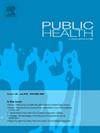Regional differences in COVID-19 vaccine uptake and their determinants among Swedish older adults
IF 3.9
3区 医学
Q1 PUBLIC, ENVIRONMENTAL & OCCUPATIONAL HEALTH
引用次数: 0
Abstract
Objectives
Regional differences in vaccine uptake constitute a threat to vaccination efforts. This study investigated factors contributing to such variation in COVID-19 vaccination (throughout the pandemic, including first, sixth dose and a 2023 autumn booster) among adults ≥65 years in Sweden.
Study design
This Swedish nationwide register-based cohort study comprised over 2 million older adults. The study periods began on December 27, 2020 for the first dose, February 1, 2022 for the sixth dose, and October 1, 2023 for the seasonal booster dose, ending on January 31, 2024.
Methods
We calculated regional age- and sex-standardized vaccine uptake rates over these periods. We used mixed-effects Poisson regression to identify associations between potential predictors (both individual- and regional-level sociodemographic and health-related factors) and vaccine uptake.
Results
The overall uptake was 95 % for the first dose, 66 % for the sixth, and 73 % for the seasonal booster. The time trend for uptake of the first dose was similar among the 21 Swedish regions. However, for the sixth and booster doses, larger, more populous regions were slower and had lower uptake rates. Individual-level factors were stronger predictors for vaccine uptake than regional-level. Male sex, born outside of Sweden, having low income and low education were associated with lower uptakes.
Conclusions
Regional differences in vaccine uptake emerged for subsequent doses as national prioritization and coordination was relaxed. Our findings underscore the importance of minimizing regional variation through targeted interventions.
瑞典老年人COVID-19疫苗接种的地区差异及其决定因素
目的疫苗接种的地区差异对疫苗接种工作构成威胁。本研究调查了导致瑞典≥65岁成年人COVID-19疫苗接种(在整个大流行期间,包括第一剂、第六剂和2023年秋季加强剂)发生这种变化的因素。这项瑞典全国性的基于登记的队列研究包括200多万老年人。第一剂疫苗的研究期开始于2020年12月27日,第六剂疫苗的研究期开始于2022年2月1日,季节性加强剂的研究期开始于2023年10月1日,到2024年1月31日结束。方法我们计算了这些时期地区年龄和性别标准化的疫苗接种率。我们使用混合效应泊松回归来确定潜在预测因素(个人和地区层面的社会人口统计学和健康相关因素)与疫苗摄取之间的关联。结果第一剂总吸收率为95%,第六剂为66%,季节增强剂为73%。在瑞典的21个地区中,首次接种的时间趋势是相似的。然而,对于第六剂和加强剂,较大、人口较多的地区接种速度较慢,吸收率较低。个体水平因素比区域水平因素更能预测疫苗接种。在瑞典以外出生、收入低、受教育程度低的男性与较低的入学率有关。结论随着国家优先级和协调的放松,后续剂量的疫苗摄取出现了区域差异。我们的研究结果强调了通过有针对性的干预措施减少区域差异的重要性。
本文章由计算机程序翻译,如有差异,请以英文原文为准。
求助全文
约1分钟内获得全文
求助全文
来源期刊

Public Health
医学-公共卫生、环境卫生与职业卫生
CiteScore
7.60
自引率
0.00%
发文量
280
审稿时长
37 days
期刊介绍:
Public Health is an international, multidisciplinary peer-reviewed journal. It publishes original papers, reviews and short reports on all aspects of the science, philosophy, and practice of public health.
 求助内容:
求助内容: 应助结果提醒方式:
应助结果提醒方式:


